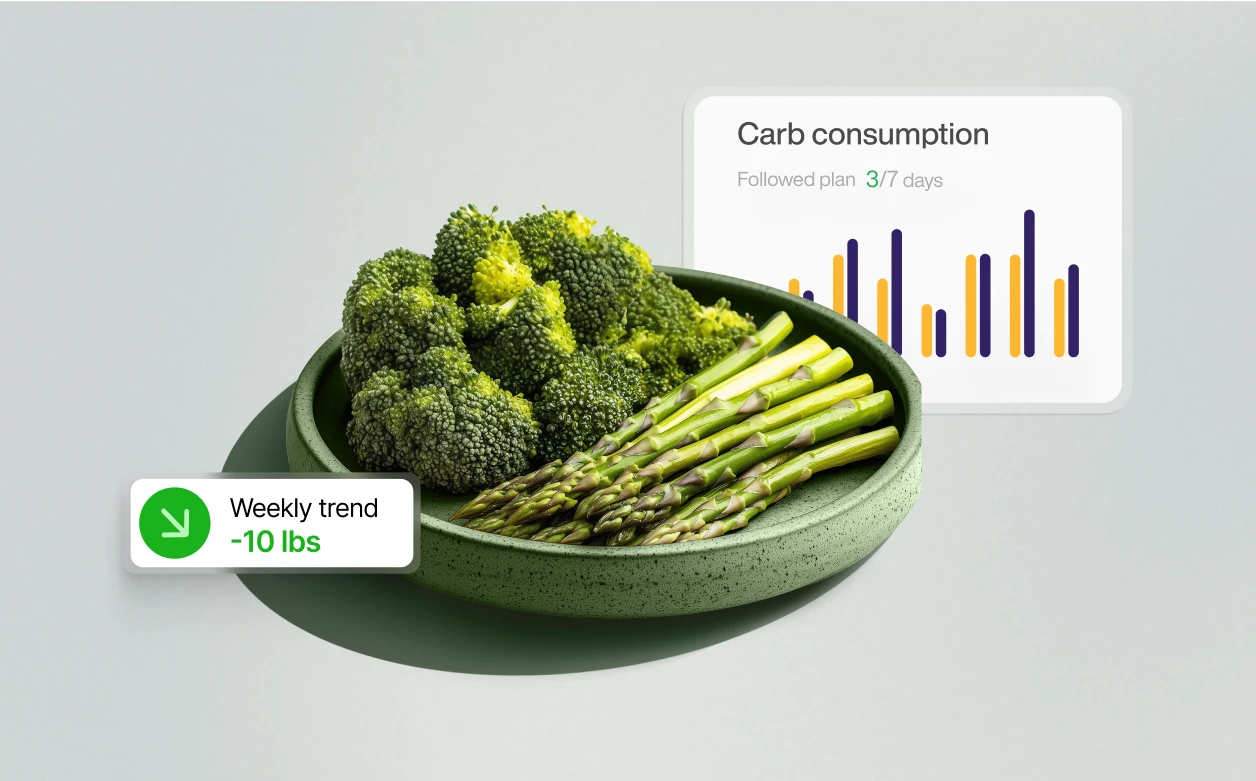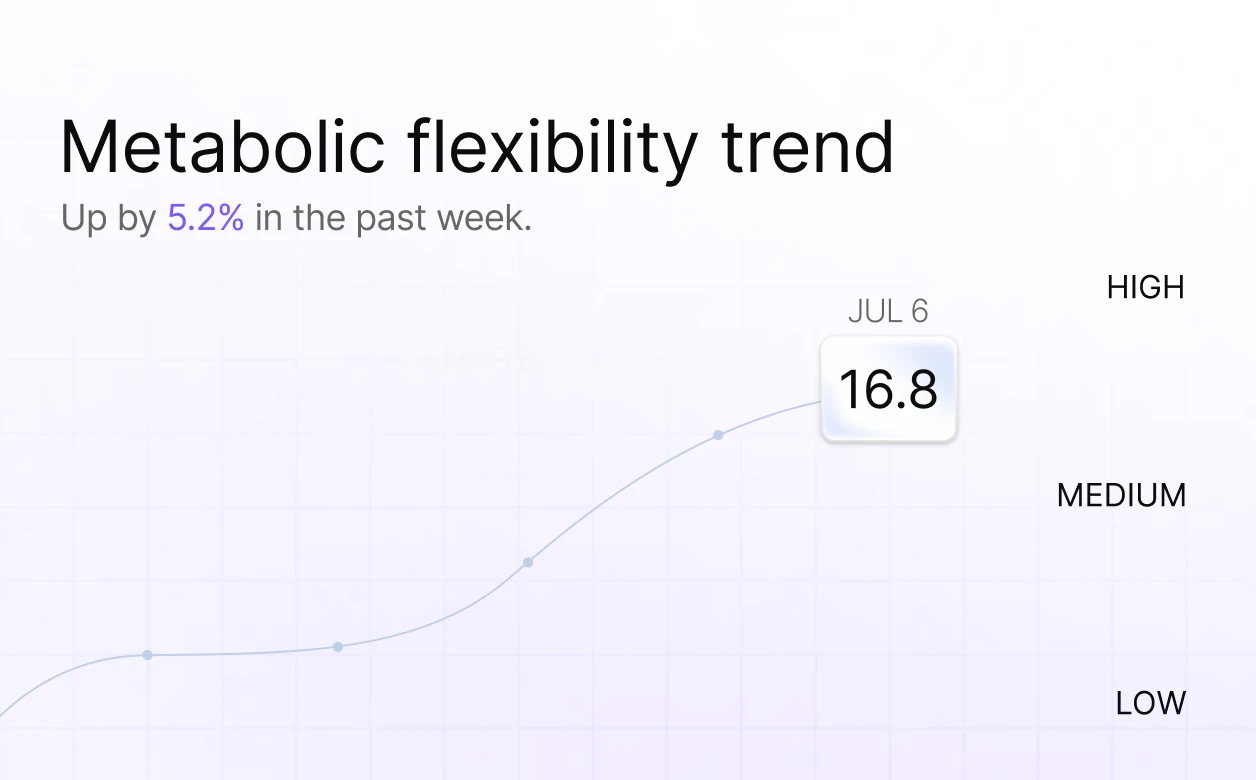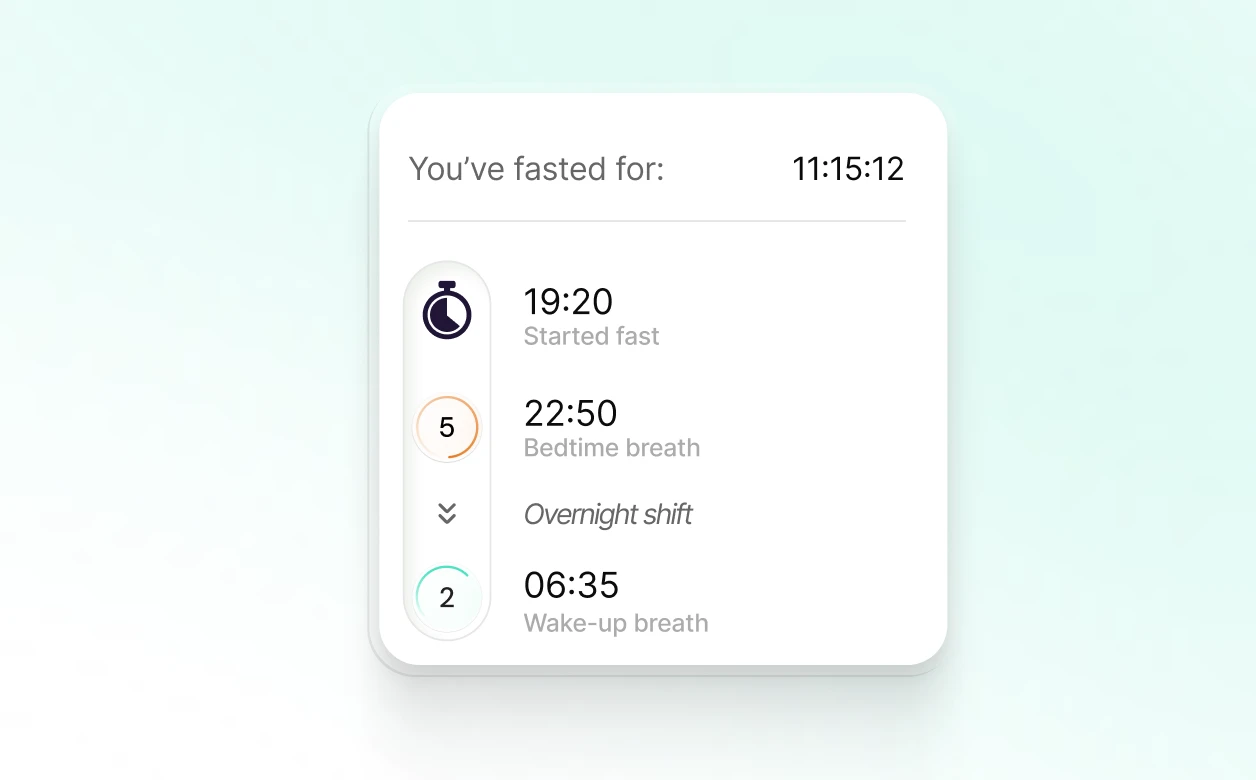Glossary
A complete glossary on all things metabolism

Anabolism
Anabolism refers to the constructive metabolic processes where the body uses energy to build and repair tissues. It involves synthesizing complex molecules (like proteins and fats) from simpler ones, supporting growth and maintenance. In practical terms, when you eat more than your body needs, anabolism can lead to storing the excess energy as fat. It’s the opposite of catabolism, working together to keep your body balanced.
Basal metabolic rate (BMR)
BMR is the amount of energy your body needs at rest to maintain vital functions like breathing, heartbeat, and temperature regulation. It typically accounts for the majority of your daily calorie burn (around 60-75%). Factors such as age, gender, muscle mass, and hormones influence BMR. For example, more muscle or certain hormones (like thyroid hormones) can increase BMR. Essentially, BMR is your “metabolic idle speed,” indicating how many calories you’d burn if you did nothing but rest for 24 hours.
Beta-oxidation
Beta-oxidation is the process by which your body breaks down fat stores to use as energy. When carbohydrates are scarce (such as on low-carb days), the body ramps up beta-oxidation to convert fat into fuel. This training of your mitochondria to use fat for energy helps improve metabolic flexibility and enhances fat burning efficiency. In simple terms, beta-oxidation is how your stored fat gets “burned off” to power your activities.
Blood sugar (blood glucose)
Blood sugar refers to the glucose circulating in your bloodstream, which is the primary fuel for your cells. After eating, carbs break down into glucose, raising blood sugar and prompting insulin release to help move glucose into cells. Balanced blood sugar supports energy stability and reduces risk of insulin resistance, fatigue, and weight gain.
Carb burn
Carb burn describes the state when your body uses carbohydrates as its primary fuel. This happens after carb-rich meals or during intense activity. Lumen detects this state with higher CO₂ levels, indicating your metabolism is burning carbs instead of fat.
Carb cycling

Carb cycling is a dietary strategy that alternates between high-carb and low-carb days. On high-carb days, carbs support workouts and muscle recovery. On low-carb days, the body turns to fat as a primary fuel source, training metabolic flexibility and supporting fat loss.
Catabolism
Catabolism is the process of breaking down complex molecules like glycogen, fat, or protein into simpler ones to release energy. This occurs during fasting, exercise, or calorie restriction. It’s the counterpart to anabolism and helps fuel body functions.
Cortisol
Cortisol is a hormone released in response to stress. It helps mobilize energy, but chronically elevated cortisol can lead to fat storage, increased cravings, and disrupted metabolism. Managing stress is key to metabolic health and fat-burning efficiency.
Fat burn
Fat burn occurs when the body primarily uses fat as its energy source. This typically happens in low-insulin states like fasting or low-carb intake. Lumen indicates fat burn with lower CO₂ readings, signaling efficient fat metabolism.
Flex Score

The Flex Score is Lumen’s metric for metabolic flexibility. It reflects how efficiently your body switches between burning fats and carbs. A higher score indicates a more adaptable metabolism, which improves energy, weight management, and long-term health.
Glucose
Glucose is the simplest form of sugar and the main energy source for your body. It comes from digesting carbohydrates and enters your bloodstream. Insulin helps move glucose into cells. Balanced glucose levels are essential for stable energy and metabolic health.
Glycogen
Glycogen is stored carbohydrate found in muscles and the liver. It serves as quick-access energy for intense activity. When glycogen is depleted via fasting or exercise, your body transitions to burning fat for fuel.
Insulin
Insulin is a hormone that regulates blood sugar by helping cells absorb glucose. After you eat, insulin moves glucose from the bloodstream into cells. Chronically high insulin from excess carbs can lead to fat storage and insulin resistance.
Insulin resistance
Insulin resistance happens when cells no longer respond effectively to insulin, causing elevated blood sugar. It often results from chronic high-carb intake. Over time, it can impair energy use, lead to fat gain, and increase the risk of type 2 diabetes.
Insulin sensitivity
Insulin sensitivity refers to how well cells respond to insulin. Higher sensitivity means your body can use glucose efficiently, resulting in stable energy and reduced fat storage. Improving insulin sensitivity is a key goal in metabolic health.
Intermittent fasting (IF)

Intermittent Fasting is an eating pattern involving cycles of eating and fasting, such as 16:8 (16 hours fasted, 8-hour eating window). It helps lower insulin, deplete glycogen, and promote fat burn, improving metabolic flexibility and energy efficiency.
Keto (ketogenic diet)
The keto diet is a low-carb, high-fat diet that shifts your body into ketosis, a state where fat becomes the main energy source. While effective for fat loss, long-term keto may reduce carb-handling ability, so Lumen recommends using it cyclically for metabolic flexibility.
Ketosis
Ketosis is the metabolic state in which your body uses fat for fuel, producing ketones. It typically occurs on low-carb or fasting protocols. Ketosis supports fat loss and energy balance, but should be cycled to preserve carb metabolism.
Macronutrients (macros)
Macros are three key nutrients: carbohydrates, proteins, and fats. Balancing macros supports muscle, fat burn, and overall metabolic health. Lumen guides personalized macro targets to optimize your energy and goals.
Metabolic flexibility
Metabolic flexibility is the ability to switch between fat and carbohydrate as fuel depending on your needs. It reflects a healthy metabolism and supports weight control, energy stability, and endurance. Lumen measures and trains this adaptability.
Metabolic health
Metabolic health means your body effectively regulates energy and maintains stable glucose, insulin, and fat levels. Good metabolic health supports energy, brain function, and weight stability, and reduces risk of chronic diseases.
Metabolic rate
Metabolic rate is the speed at which your body burns calories to support life and activity. A faster metabolic rate can help with weight management and energy. It’s influenced by muscle mass, hormones, and activity.
Metabolic syndrome
Metabolic syndrome is a group of risk factors, like insulin resistance, high blood pressure, and excess fat around the waist, that raise the chance of chronic disease. Improving diet, movement, and metabolism can reverse it.
Metabolism
Metabolism is the sum of all processes that convert food into energy and building blocks for the body. It includes both breaking down food (catabolism) and using energy to grow and repair (anabolism). A well-functioning metabolism ensures vitality and balance.
Metabolism boost (boosting metabolism)
Boosting metabolism means increasing the energy your body burns at rest and during activity. This can be achieved by building muscle, exercising, eating protein-rich foods, getting enough sleep, and managing stress. Boosting your metabolism helps with fat loss, energy, and overall health.
Micronutrients
Micronutrients are essential vitamins and minerals like iron, zinc, and vitamin D that support metabolism, immunity, and overall health. They’re vital for your body to run properly, and a diverse diet helps you meet your micronutrient needs.
Mitochondria
Mitochondria are the energy-producing structures inside cells. They convert carbs and fats into usable energy (ATP). A strong, abundant mitochondrial network improves metabolism, fat burn, and endurance. Exercise and diet help boost mitochondrial function.
Muscle mass (lean mass)
Muscle mass refers to the amount of lean tissue in your body. Muscle burns more calories than fat and supports fat loss and metabolic rate. Strength training and adequate protein intake help build and maintain lean mass for a stronger metabolism.
Respiratory exchange ratio (RER)
RER is a measurement used to determine what fuel, carbs or fat, your body is using. Lumen approximates RER through CO₂ levels in your breath. Lower values mean fat burn; higher values mean carb burn. It’s a direct window into your current metabolic state.
Thermic effect of food (TEF)
TEF is the energy used by your body to digest and process food. Protein has the highest TEF, meaning it burns more calories during digestion. TEF contributes to daily calorie burn and is one reason why whole foods aid weight management.
Time-restricted eating (TRE)
TRE limits eating to a specific window each day (like 10am–6pm). It’s a type of intermittent fasting that supports insulin sensitivity, fat burn, and circadian rhythm alignment. TRE is simple and effective for many metabolic goals.
Total daily energy expenditure (TDEE)
TDEE is the total number of calories you burn in a day from all activities: resting, moving, and digesting food. Knowing your TDEE helps you set calorie targets for weight loss or maintenance.
Weight loss plateau
A weight loss plateau happens when progress stalls despite continued effort. It’s often due to metabolic adaptation after weight loss. To overcome it, adjust your workouts, increase protein intake, or improve metabolic flexibility with strategies like carb cycling.
Yo-yo dieting
Yo-yo dieting is the repeated cycle of starting and stopping diets due to weight loss and regain. Sustainable nutrition strategies and improving metabolic flexibility help break this pattern and support long-term weight loss success.







 Digital download
Digital download